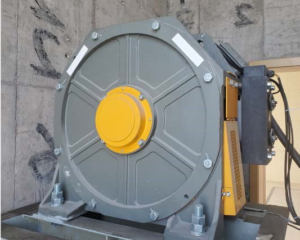 The battery can deliver up to 25 kW with higher peaks. The counterweight has a mass of a 1000 kg. Depending on the mass of the load (vs. the counterweight) and the elevator’s direction excess energy will be absorbed by the hybrid supercapacitor battery. Alternatively, it supplies energy to the motor, reducing the energy delivered from the grid connection. The test setup aimed at measuring the energy savings. The test executes 10 up and down runs with no load, a 25%, a 75%, a 100% load and in all cases with the battery connected and disconnected. The elevator moves at 2.5 m/s. The energy savings reach about 50% in the 2 extreme cases (no load, 100% load) as was to be expected but also showing that the energy losses of the elevator and battery set-up are minimal.
The battery can deliver up to 25 kW with higher peaks. The counterweight has a mass of a 1000 kg. Depending on the mass of the load (vs. the counterweight) and the elevator’s direction excess energy will be absorbed by the hybrid supercapacitor battery. Alternatively, it supplies energy to the motor, reducing the energy delivered from the grid connection. The test setup aimed at measuring the energy savings. The test executes 10 up and down runs with no load, a 25%, a 75%, a 100% load and in all cases with the battery connected and disconnected. The elevator moves at 2.5 m/s. The energy savings reach about 50% in the 2 extreme cases (no load, 100% load) as was to be expected but also showing that the energy losses of the elevator and battery set-up are minimal.
| Load | Battery connected | Energy used per up/down cycle (kWh) | Energy savings |
| No load | Yes | 0,1048 | |
| No | 0,0729 | 50,84% | |
| 25% | yes | 0,0729 | |
| No | 0,101 | 27,11% | |
| 50% | Yes | 0,0788 | |
| no | 0,0811 | 2.74% | |
| 75% | Yes | 0,1043 | |
| No | 0,1800 | 42,07% | |
| 100% | Yes | 0,1491 | |
| No | 0,2922 | 48,97 |
Finally, a fault case was tested whereby the grid connection was removed and the up-down cycle was executed 10 times. The hybrid supercapacitor battery supplied the energy with no issues. Below pictures of the set-up
 |
|


Recent Comments